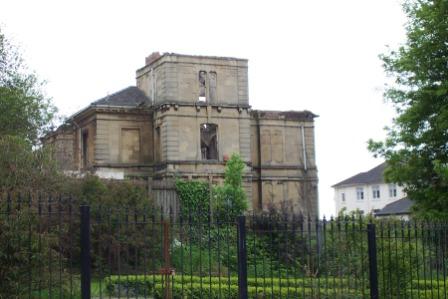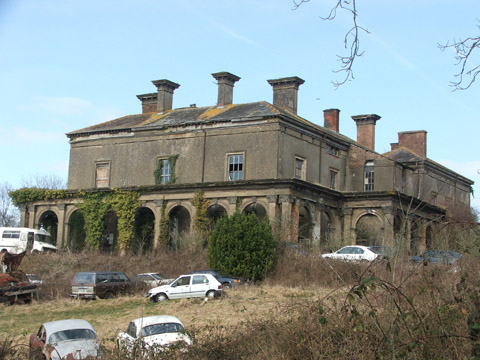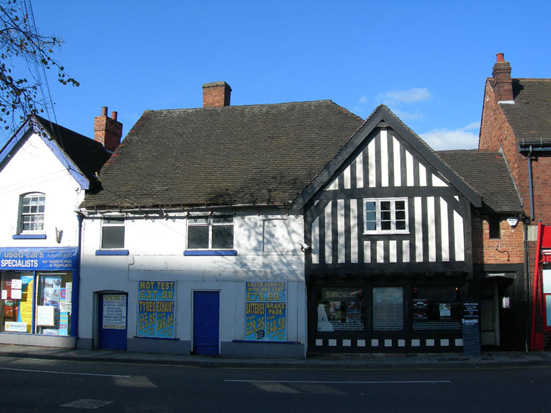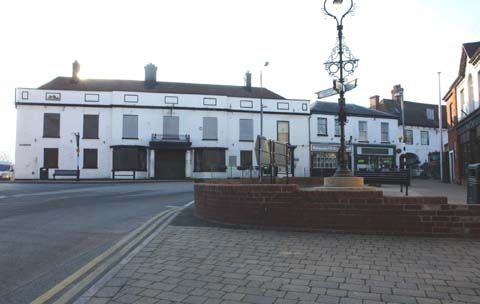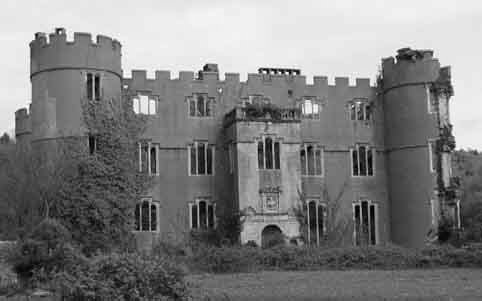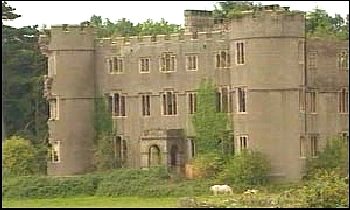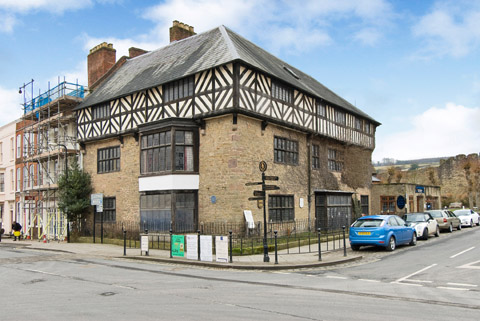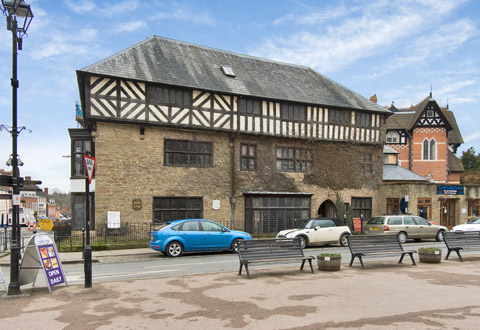Buildings at risk for sale - take your pick!
SAVE has heard of many fine buildings at risk for sale recently and felt compelled to write an article rather than waiting to feature them each as a building of the month.
We are hoping that these intriguing properties which range widely in type, size and condition will tempt restoring owners. Highlights include an empty mental asylum in the Brecon Beacons National Park in Wales, an unusual and partially occupied country house in Devon, the grounds of which are being used as a car scrap yard and a ruined castle in North Wales.
Mid-Wales Hospital, Talgarth
Neglected for over a decade, the Mid-Wales Hospital in Talgarth is a former mental asylum in the beautiful Brecon Beacons National Park which has been allowed to fall into disrepair. It is for sale (price on application) and advertised as a ‘Mixed-use Development Opportunity'. There is enormous potential for reuse and it could be converted into spectacular flats with the right scheme. However, instead it has become a playground for vandals and time and neglect have taken their toll and the various handsome buildings on the site are now in a dilapidated state. Security has recently been tightened but this fine collection of buildings needs someone to come forward soon to rescue them from dereliction.
Interested parties should move fast as offers are being accepted until the 27th of October 2010.
David Currie & Co. Tel: 0161 835 9559. Link to property details.
The site comprises 33.5 acres, 11.5 of which are developed.
Photos: Mark Davis Photography
Blackborough House, Cullompton, Devon
Blackborough House is a Grade II listed country house on the edge of the Blackdown Hills in Devon and is an enigmatic and interesting building with an eccentric history. It was on the market a few years ago with Knight Frank but failed to sell and is now on the market again with Winkworth for £1 million to £1.5 million.
In a recent article in The Times the owner was quoted saying he would like to see it restored as a family home. Currently it is partially occupied and surrounded, and compromised by scrap metal yards.
Built in 1838 by the fourth and last Earl of Egremont, it was intended to be a grand Italianate palace but this plan was dashed by financial difficulties and the house was not completed. Instead, it was split into matching halves and the Earl occupied one half, while the local rector, a cousin, occupied the other. The architecture has naval references – the Earl was a naval man and the small square windows on the upper floors were supposed to resemble gunports on his ship, the Hawke.
In decline for several decades, Blackborough was described as semi-derelict at the time of its listing in 1985. It will need both structural and historic reports and the state of the interior is unknown as the council has only seen parts because some of it cannot be safely accessed.
Blackborough House has enjoyed many different incarnations – as a school, a home for ‘wayfarers’, a base for a religious sect and an internment camp for conscientious objectors. SAVE hopes this unusual house will be given a new lease of life soon. Its location 12 miles from Exeter and ten minutes from the M5 may help its case. Although it could make a wonderful family home, transformation into a hotel would also be a possibility.
Link to property details.
Photos: Danny Simmons
Swaggers, 111 Lichfield Street, Tamworth, Staffordshire
Ever dreamt of running your own B&B and bar in a historic building? Well, now might be your chance! Swaggers is a charming timber framed building in the centre of Tamworth, a historic market town in Staffordshire. Until recently it was a popular bar and B&B. It is now for sale and could be a great restoration project.
Although the original character of Swaggers has been upset by modern alterations (the timber frame has been infilled with brick for example), a considerate restoration could make this building shine again and enhance the streetscape.
It is on the market for £194,950 with Sidney Phillips 01981 250333 and was featured in SAVE’s 2008 buildings at risk catalogue, Cherish or Perish. We would love to see this building restored and in the hands of a caring and sympathetic owner.
Link to property details.
The Newcastle Arms, Tuxford, Nottinghamshire
Tuxford is a charming and historic market town and one of its best known landmarks, the Newcastle Arms, is now for sale with Brown & Co. Situated in the Market Place it is a Grade II listed, mid-18th-century building with 19th-century additions. It has a handsome facade with a fine Doric porch. It is noted in the Pevsner guide to the buildings of Nottinghamshire.
The building has been vacant, unloved and in wait for a saviour for several years. This part of Tuxford is a conservation area and was highlighted in English Heritage’s 2009 campaign as a conservation area at risk. For this reason, Bassetlaw District Council is in the process of starting a grant partnership scheme with EH and Nottinghamshire County Council over the next three to five years to restore the centre of the village. The conservation officer is currently liaising with the owner of the Newcastle Arms.
Planning permission has been given for conversion into 16 apartments. The plans can be viewed online with the reference 50/10/00023. There is also planning permission to erect four semi-detached dwellings and convert the pub for office/commercial/retail use and the plans can be viewed online with the reference 50/09/00060/R. Alternatively, (and probably ideally) it could be reinstated as a hotel; no doubt the regeneration of Tuxford will bring more visitors in to the town and attract more businesses and investment.
Price undisclosed.
Brown & Co, Retford
Email: retford@brown-co.com
Tel: 01777 709112
Ruperra Castle, Lower Machen, Newport
Ruperra Castle between Lower Machen and Rudry near Newport in Wales has been neglected and decaying for half a century. It is now for sale with Savills for £1.5million and SAVE hopes that this forgotten gem will be rescued and restored to its former glory.
Ruperra Castle is one of Wales' most important buildings and has an interesting history - Grade I listed, it was built in 1626 by Sir Thomas Morgan who was knighted by James 1st. The Morgans were wealthy landowners who also built Plas Machen, a 15th century gentry house which featured in this year’s buildings at risk catalogue, Live or Let Die, which is also for sale. Link to property details).
Charles 1st is believed to have stayed at Ruppera in 1645 when he was raising support after the Battle of Naseby and Captain Godfrey Charles Morgan of the Charge of the Light Brigade fame became Lord Tredegar in 1875 when the castle was enjoying its heyday as a Victorian country estate.
Two fires have ravaged the castle. After the first, in 1785, the castle was rebuilt largely as we see it today, and the second, in 1941 when British troops were billeted there during WW2, hastened the castle’s steady decline.
The castle was sold after the War and then again in 1956 and since then has remained in the same ownership. In the last decade, the current owners submitted planning applications for the development of the castle and its outbuildings with a further 15 new houses in the grounds. However, this was refused, as was the appeal as it was considered that the plans would harm the setting of the castle.
Ruperra Castle may look the picture of the romantic crumbling castle, but the situation is critical with over fifty years of neglect and lack of maintenance having taken their toll.
The south-eastern tower collapsed in 1982 and there are three large cracks in the other three. Ruperra desperately needs major repairs if it is to survive. The restoration of this sleeping beauty is not for the faint hearted but the rewards would be plentiful.
Ruperra's closest architectural twin is Lulworth castle, which was also burnt out in the 20th century. Recently the restoration of Lulworth was completed by English Heritage. SAVE hopes that Ruperra will experience similar good fortune.
A preservation trust was set up for the castle and the website is essential reading for anyone interested in Ruperra and has a gallery of photographs of this achingly beautiful forgotten castle.
Castle House, Castle Square, Ludlow, Shropshire
This last building is not at risk, but we could not resist including it in this article because it is such a gem. Listed in Simon Jenkins’ book, England’s 1000 Best Houses, it is Grade II* listed, in good condition and recently occupied as a private residence. This stunning townhouse in the centre of Ludlow is on the market for £1.35 million and could make a wonderful home.
It has a 14th century stone ground floor and overhanging 16th century timberwork above. Its striking exterior makes a positive contribution to the streetscape and Castle Lodge is something of a local landmark. Inside there is imported 16th – 19th century panelling, decorative plaster ceilings, stained glass windows each with a unique design and impressive fireplaces, all of which add to the amazing feeling of grandeur and history.
There are connections with famous figures from history - Lady Jane Grey lived here as a child, it was home to Katherine of Aragon for a short time in 1501 and Cromwell and his men were billeted here during the Civil War.
With 12 bedrooms, various reception rooms and a small courtyard garden, the sale of this property is enticing. Ludlow is an attractive town known for its historic buildings, famous for its many festivals and is surrounded by the beautiful Welsh Marches.
SAVE would like to see a sensitive owner keen to act as custodian take on this fine house. It could earn its keep by being a B&B for the many tourists that visit Ludlow each year, could host historical tours and cash in on its connections or could be even be used as a film location.
For sale with Hayes Sales & Lettings Ltd on 01531 888064. Link to the property details.
11 Kensington Grove, Newport, Wales
SAVE welcomes the news that Newport City Council plans to serve a Compulsory Purchase Order (CPO) on the owners of 11 Kensington Grove in Newport, a derelict Italianate villa set in just under an acre of land.
This crumbling Grade II listed building (located within the Kensington Place Conservation Area) was built in the 1870s. It is a fine example of its type and a prominent local landmark. However, its critical condition (it is roofless and has suffered partial collapse) has led to the council’s decision to initiate compulsory purchase. The council is now looking for an experienced and sympathetic developer partner to take on the building for a nominal sum as part of a back-to-back agreement. The council is prepared to consider some enabling development to fund the restoration. Possibilities for the building’s future include residential or office use.
For further information please contact Bob Bowler, conservation officer at Newport City Council.
01633 232163
bob.bowler@newport.gov.uk
Link to sales flyer.

